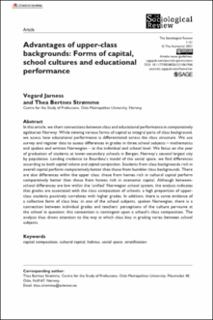| dc.contributor.author | Jarness, Vegard | |
| dc.contributor.author | Strømme, Thea Bertnes | |
| dc.coverage.spatial | Norway | en_US |
| dc.date.accessioned | 2022-06-10T13:12:48Z | |
| dc.date.available | 2022-06-10T13:12:48Z | |
| dc.date.created | 2021-12-06T15:17:29Z | |
| dc.date.issued | 2021-12-02 | |
| dc.identifier.citation | Sociological Review. 2021, 1-21. | en_US |
| dc.identifier.issn | 0038-0261 | |
| dc.identifier.issn | 1467-954X | |
| dc.identifier.uri | https://hdl.handle.net/11250/2998335 | |
| dc.description.abstract | In this article, we chart connections between class and educational performance in comparatively egalitarian Norway. While viewing various forms of capital as integral parts of class background, we assess how educational performance is differentiated across the class structure. We use survey and register data to assess differences in grades in three school subjects – mathematics and spoken and written Norwegian – at the individual and school level. We focus on the year of graduation of students at lower-secondary schools in Bergen, Norway’s second largest city by population. Lending credence to Bourdieu’s model of the social space, we find differences according to both capital volume and capital composition. Students from class backgrounds rich in overall capital perform comparatively better than those from humbler class backgrounds. There are also differences within the upper class: those from homes rich in cultural capital perform comparatively better than those from homes rich in economic capital. Although between-school differences are low within the ‘unified’ Norwegian school system, the analysis indicates that grades are associated with the class composition of schools: a high proportion of upper-class students positively correlates with higher grades. In addition, there is some evidence of a collective form of class bias: in one of the school subjects, spoken Norwegian, there is a connection between individual grades and teachers’ perceptions of the culture pervasive at the school in question; this connection is contingent upon a school’s class composition. The analysis thus draws attention to the way in which class bias in grading varies between school subjects. | en_US |
| dc.language.iso | eng | en_US |
| dc.publisher | SAGE Publications | en_US |
| dc.relation.ispartofseries | Sociological Review; | |
| dc.rights | Navngivelse 4.0 Internasjonal | * |
| dc.rights.uri | http://creativecommons.org/licenses/by/4.0/deed.no | * |
| dc.subject | Capital compositions | en_US |
| dc.subject | Cultural capital | en_US |
| dc.subject | Habitus | en_US |
| dc.subject | Social spaces | en_US |
| dc.subject | Stratification | en_US |
| dc.title | Advantages of upper-class backgrounds: Forms of capital, school cultures and educational performance | en_US |
| dc.type | Peer reviewed | en_US |
| dc.type | Journal article | en_US |
| dc.description.version | publishedVersion | en_US |
| dc.rights.holder | © The Author(s) 2021 | en_US |
| cristin.ispublished | true | |
| cristin.fulltext | original | |
| cristin.qualitycode | 2 | |
| dc.identifier.doi | https://doi.org/10.1177/00380261211061946 | |
| dc.identifier.cristin | 1965186 | |
| dc.source.journal | Sociological Review | en_US |
| dc.source.pagenumber | 1-21 | en_US |
| dc.relation.project | Norges forskningsråd: 315389 | en_US |

